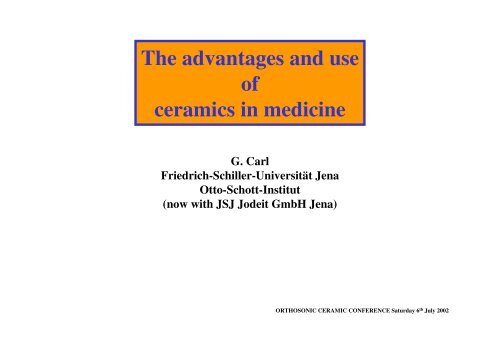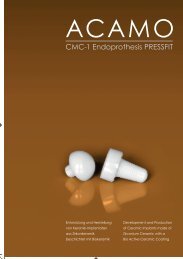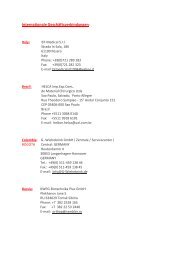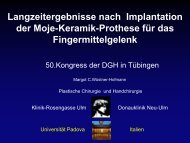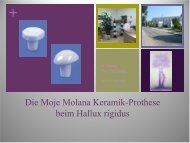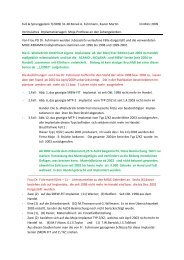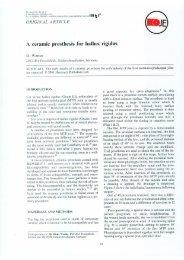Bioceramics-Dr. Carls 2 - G.-Wiehebrink
Bioceramics-Dr. Carls 2 - G.-Wiehebrink
Bioceramics-Dr. Carls 2 - G.-Wiehebrink
You also want an ePaper? Increase the reach of your titles
YUMPU automatically turns print PDFs into web optimized ePapers that Google loves.
The advantages and use<br />
of<br />
ceramics in medicine<br />
G. Carl<br />
Friedrich-Schiller-Universität Jena<br />
Otto-Schott-Institut<br />
(now with JSJ Jodeit GmbH Jena)<br />
ORTHOSONIC CERAMIC CONFERENCE Saturday 6 th July 2002
ioceramics<br />
bioceramics<br />
bioglasses<br />
bioglass-ceramics
dens, nonporous<br />
/porous<br />
granules<br />
/powder<br />
bioceramics<br />
coatings<br />
components<br />
of<br />
composites
ioinert<br />
- alumina ceramic<br />
- zirconia ceramic<br />
- glassy carbon<br />
biotolerant<br />
-glass-ceramics<br />
without<br />
apatite crystals<br />
bioceramics<br />
bioactive<br />
-hydroxyapatite<br />
-bioglasses<br />
-bioglass-ceramics<br />
with apatite<br />
bioresorbable<br />
- ß-TCP<br />
- bioglasses<br />
- bioglass-ceramics
alumina bioceramic<br />
- high-density / high-purity -<br />
⇒ good biocombatibility<br />
⇒ excellent corrosion resistance<br />
⇒ high wear resistance<br />
⇒ low coefficient of friction<br />
⇒ very low surface roughness values<br />
⇒ high strength<br />
⇒ high fracture toughness
properties<br />
Al 2 O 3 content [wt-%]<br />
density [g/cm³]<br />
average grain size [µm]<br />
hardness [HV]<br />
bending strength [MPa]<br />
Youngs Modulus [GPa]<br />
properties of alumina bioceramic<br />
compressive strength [MPa]<br />
fracture toughness [MPa*m -1/2 ]<br />
alumina<br />
bioceramic<br />
> 99,8<br />
> 3,93<br />
3-6<br />
2300<br />
4500<br />
550<br />
380<br />
5-6<br />
ISO alumina<br />
standard 6474<br />
≥ 99,5<br />
≥ 3,9<br />
< 7<br />
> 2000<br />
400
microstructure<br />
alumina bioceramic<br />
contact angle
one<br />
screws<br />
hip<br />
prostheses<br />
balls &<br />
sockets<br />
alveolar<br />
ridge<br />
keratoprostheses<br />
corneal<br />
replacements<br />
alumina<br />
ceramic<br />
maxillofacial<br />
reconstructions<br />
knee<br />
prostheses<br />
middle ear<br />
implants<br />
dental<br />
implants
clinical applications of alumina bioceramic
properties<br />
density [g/cm³]<br />
average grain size [µm]<br />
hardness [HV]<br />
bending strength [MPa]<br />
Youngs Modulus [GPa]<br />
properties of zirconia bioceramic<br />
ZrO 2 / Al 2 O 3 content [wt-%]<br />
fracture toughness [MPa*m -1/2 ]<br />
zirconia<br />
bioceramic<br />
> 97<br />
5,6 – 6,1<br />
1<br />
1300<br />
1200<br />
200<br />
15<br />
alumina<br />
bioceramic<br />
≥ 99,8<br />
≥ 3,93<br />
3-6<br />
2300<br />
550<br />
380<br />
5 - 6
Moje zirconia implants
iotolerable bioglass-ceramics<br />
♠ systems<br />
⇒ mica glass-ceramics (machinable) - Bioverit ® II<br />
microstructure of mica glass-ceramics with plate like (right) and curved<br />
mica crystals (left, Bioverit ® II), scanning electron micrograph
iotolerable bioglass-ceramics<br />
♠ systems<br />
⇒ mica glass-ceramics (machinable)<br />
⇒ leucite glass-ceramics<br />
⇒ lithium silicate glass-ceramics<br />
♠ properties<br />
⇒ biocompatible, non-toxic<br />
⇒ high chemical resistance<br />
⇒ good mechanical properties<br />
♠ clinical applications<br />
⇒ dental restorations<br />
⇒ middle ear implants<br />
⇒ skull reconstructions
skull cap<br />
biotolerable mica bioglass-ceramic Bioverit ® II<br />
dental restorations - inlays<br />
middle ear implants
ioactive bioceramics<br />
hydroxyapatite – Ca 10(PO 4) 6(OH) 2<br />
♠ clinical applications<br />
⇒ bone void filler<br />
(nonporous, porous – coraline)<br />
⇒ coatings<br />
♠ properties<br />
⇒ high biocompatibility<br />
⇒ high bone bonding ability<br />
⇒ high chemical resistance<br />
⇒ low mechanical strength<br />
microstructure of a porous hydroxyapatite ceramic
ioactive bioceramics<br />
hydroxyapatite – Ca 10(PO 4) 6(OH) 2
ioactive bioceramics<br />
bioglass ®<br />
♠ sytem: Na 2 O-CaO-SiO 2 -P 2 O 5 -(F - )
ioactive bioceramics<br />
bioglass ®<br />
♠ properties<br />
⇒ excellent biocompatibility<br />
⇒ high bio reactivity<br />
⇒ high bone bonding ability<br />
⇒ low chemical resistance<br />
⇒ low mechanical strength<br />
♠ clinical applications<br />
⇒ bone void filler<br />
⇒ coatings<br />
⇒ composites<br />
⇒ middle ear implants<br />
⇒ dental implants
ioglass-ceramics<br />
System<br />
crystal phases<br />
bone bonding<br />
ability<br />
chemical<br />
resistance<br />
mechanical<br />
strength<br />
apatite<br />
low<br />
low<br />
bioactive bioceramics<br />
bioglass-ceramics<br />
Ceravital ®<br />
Na 2 O-CaO-SiO 2 -<br />
P 2 O 5<br />
very high<br />
apatite,<br />
wollastonite<br />
very high<br />
high<br />
high<br />
Cerabone ®<br />
MgO-CaO-SiO 2 -<br />
P 2 O 5 -F -<br />
Na 2 O-K 2 O-MgO-<br />
Al 2 O 3 -CaO-SiO 2 -<br />
P 2 O 5 -F -<br />
apatite<br />
mica<br />
high<br />
high<br />
high<br />
Bioverit ®
electron-beam microprobe<br />
investigation of<br />
the intergrowth zone<br />
between bone (left) and<br />
bioglass-ceramic<br />
Bioverit ® I (right)<br />
bioactive bioglass-ceramic Bioverit ® I<br />
intergrowth between<br />
bone and glassceramic<br />
Bioverit ® I<br />
(scanning electron<br />
micrograph)<br />
intergrowth between<br />
bone (yellow) and glassceramic<br />
Bioverit ® I<br />
(optical micrograph)
ioactive bioceramics<br />
bioglass-ceramics<br />
♠ clinical applications<br />
⇒ bone spacer<br />
⇒ coatings<br />
⇒ composites<br />
⇒ distance-keeping implants in osteotomy<br />
⇒ artificial vertebras<br />
⇒ dental implants<br />
glass-ceramic implants of Bioverit ® I
ioresorbable bioceramics<br />
♠ systems<br />
⇒ ß-TCP (ß-tri calcium phosphate)<br />
⇒ phosphate glasses and glass-ceramics<br />
♠ properties<br />
⇒ high biocompatibility<br />
⇒ controlled resorption or biodegratation<br />
⇒ low chemical resistance<br />
⇒ poor mechanical strength<br />
♠ clinical applications<br />
(powder, porous solid, dens solid)<br />
⇒ bone void filler
coatings with bioactive ceramics<br />
* technology:<br />
⇒ plasma spraying<br />
⇒ sputtering<br />
⇒ sol-gel-process<br />
⇒ sintering<br />
* requirements:<br />
⇒ good biocompatibility, bone bonding<br />
⇒ similar thermal expansion coefficients<br />
⇒ high chemical stability<br />
⇒ good adhesive strength of the coating<br />
⇒ no changes of the substrates by the coating process
ioactive glassceramic<br />
Bioverit ® I<br />
coated zirconia<br />
endoprostheses<br />
Bioverit ® I coating on Moje zirconia prostheses<br />
* coating process<br />
milling<br />
(d ~ 10 µm)<br />
zirconia<br />
endoprostheses<br />
sintering process<br />
at 1200 – 1300 °C<br />
mixing of the<br />
powder with water<br />
painting of the slip<br />
and drying
Bioverit ® I coating on Moje zirconia prostheses<br />
* results<br />
⇒ good biocompatibility, bone bonding ability<br />
⇒ dense and crack-free layer<br />
⇒ long term stability<br />
⇒ good adhesive strength of the coating<br />
⇒ no changes of the zirconia ceramic<br />
microstructure of the coating,<br />
scanning electron micrograph<br />
intergrowth of coating and bone,<br />
optical photomicrograph
⎮<strong>Bioceramics</strong>:<br />
summary<br />
wide range of biological properties<br />
different chemical compositions<br />
various chemical and mechanical properties<br />
different shape and size<br />
wide range of clinical applications
Ergänzungsfolien
ioceramics – interface range
ioactive bioglass-ceramic Bioverit ® I<br />
bone connection<br />
bone connection in dependence of the time of implantation in an animal experiment –<br />
glass-ceramic Bioverit ® I implants in comparison to corundum implants


